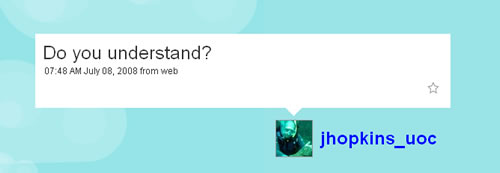As mentioned before, earlier this week I had the chance to hold a workshop on social media in higher education at Universitat Oberta de Catalunya (UOC). (Slides below or on Slideshare). It was a great group, very active and engaged despite their completely different backgrounds and the language barrier. (Thanks guys!)
Special thanks, again, to Josep Maria Duart, who invited me and Carlos Albaladejo, who organized everything (including a lot of green cables) and blogged live from the workshop.
(This presentation is licensed under Creative Commons Attribution Sharealike, so you can use it both non-commercially or commercially as long as you do two things: a) reference me as the author and b) share your stuff under the same license.)
The workshop was roughly divided into three parts: A bit of Web 2.0 theory, just the basics plus some case studies of social media use in higher education; Then a practice session where we’d split up and play around with blogs, Flickr, Twitter etc; And a final part where the audience would share their experiences and we’d develop new ideas for social media use in the classroom.
This structure seemed to work quite well; maybe a stronger focus on practical applications would have made sense, i.e. maybe I should have shown more tools & tricks. Altogether, though, I have a good feeling everybody learned a fair bit, including me:
1.) Twitter, it was agreed on, isn’t the primary choice for in-class teaching. Which totally makes sense here, given that UOC is a virtual university and everything is done online anyway. Also, Twitter tends to draw a lot of attention, so you want to factor in some extra time for discussion if you show Twitter (which worked fairly stable – no fail whale sightings at all!). Twitter, it was proposed, would make a good presentation tool: “Begin with twitter, use it for presenting tools, end with theory.” By the way, nothing beats the effect of discovering your colleagues posting live, it’s always a blast:
2.) Blogs and Wikis are a great start for university courses to start using social media. Wikis are harder to maintain as the entry barrier (syntax and writing culture) is higher. Blogs are easy to start, and I was glad to hear that one department was afraid of enabling comments until they noticed that the comments were overwhelmingly constructive – now they’re open and not moderated. Great!
3.) Flickr can be useful, but it’s probably won’t be a key service for your classroom – unless you are looking for photos licensed under a Creative Commons license that allows you to use the photos for free as long as you link back to the source. You can search for those photos here.
4.) Etiquette in our times of digital social network is still evolving, and quickly. What do we post online, why and how do we post? Should teachers be Facebook friends of their students? How much of a role do cultural differences between the U.S. and Europe play when interacting online?
5.) One thing, however, clearly stood out. Everybody agreed there is one major issue with everything Web 2.0: Time. Time, time and time. Maintaining social web tools like wikis, Facebook or Twitter takes time, and a lot of it. Where should that extra time come from, or where else can we save it?
To wrap this post up, here’s a few more links.
Links & tools that might be useful:
- Google Feedreader to follow many RSS feeds more easily
- Summize.com to scan Twitter for interesting conversations about certain keywords
- del.icio.us to collect your bookmarks and share them with friends and colleagues (my bookmarks for elearning)
Useful articles, posts and blogs:
- 21st Century classrooms and learning (via Howard Rheingold’s del.icio.us bookmarks)
- Digital Youth Research
- TIMES Online: How the Google generation thinks differently
- Digital Media and Learning, supported by the MacArthur Foundationweblogs@University of British Columbia
- And, for those not teaching or working at UOC, the UOC’s UNESCO chair in E-Learning blog.
Thanks again everybody for the great time, and please feel free to get in touch anytime via email or Twitter.


